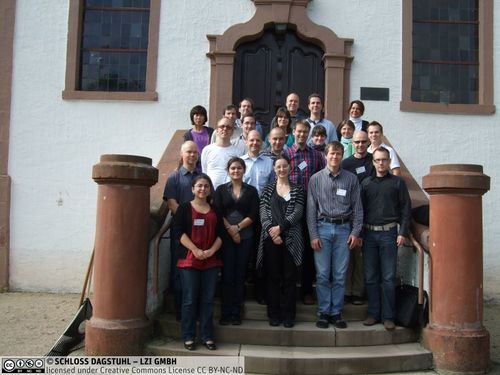Dagstuhl Seminar 10403
Impact of Human Mobility on Communications: Measurement, Analysis, Modeling, and Simulation
( Oct 06 – Oct 09, 2010 )
Permalink
Organizers
- Kevin C. Almeroth (University of California - Santa Barbara, US)
- Gunnar Karlsson (KTH Royal Institute of Technology, SE)
- Cecilia Mascolo (University of Cambridge, GB)
- Jörg Ott (Aalto University, FI)
Contact
- Annette Beyer (for administrative matters)
Schedule
Human mobility can be classified using three levels: strategic, tactical and operational mobility. At the strategic level humans decide their daily movement patterns and activities, such as go to work or to walk in the park. The tactical level considers the implementation of a strategic decision, such as choosing a way of travel. At the operational level, human movement is considered, including speed, physical size of nodes and interaction with others due to queuing or for avoiding collisions.
Capturing mobility in all its facets is crucial to the evaluation of mobile communication systems since it affects the quality and availability of a radio channel. There are two trends that motivate a closer look at mobility. First, the spatial dimensions of cellular wireless communication systems are shrinking with their evolution to enable spatial reuse of spectral bands and higher data rates per node. The second trend is the interest in self-organizing ad hoc networks, as connected multi-hop networks or sparse intermittently connected delay-tolerant networks. When cell sizes shrink and multi-hop ad hoc communication becomes more prevalent, it is apparent that mobility is not only affecting the radio channel but is also causing churn in mobile networks and intermittency.
The performance of wireless communication systems is likely to be affected in a different way by each level of mobility. Decisions at the strategic and tactical levels determine the regularity and routines in movement which in turn affect how and when nodes interact with each other or with infrastructure. Some routing protocols for delay-tolerant networks try to take advantage of such non-randomness to route messages to a destination node. Mobility at the operational level presumably affects node connectivity and individual contact durations. This determines the amount of data that can be transferred per contact. Predictability and repeatability are thus two important aspects of movement patterns.
The mobility used in performance evaluation is synthetic and has several shortcomings including: 1) Migration of people in and out of a modeled area is missing; 2) There are few models that consider obstacles; 3) Periodicity and predictable patterns are not captured; and 4) User behavior, social relationships, and community structure is absent. Recently, there has been interest in measuring mobility, albeit in small and controlled groups (e.g., participants at a conference, or a sample of students on a campus). The measurement results allow for realism but are difficult to generalize from the often small scale and infrequent measurements.
This seminar highlighted human mobility and its connection to communication processes. We considered a wide variety of mobility types and will discussed means to capture mobility on the strategic, tactical and operational levels. In addition to radio communication, we discussed the traffic patterns from mobile nodes and potential correlation between mobility and communication patterns with respect to the three levels. The seminar brought together researchers who take different approaches to mobility and pursue different methodologies: from measurements and analyses in social sciences to mobility modeling and simulations for understanding the impact of mobility on communication protocols and systems.
- Nils Aschenbruck (Universität Bonn, DE) [dblp]
- Sonja Buchegger (KTH Royal Institute of Technology, SE) [dblp]
- Song Chong (KAIST - Daejeon, KR)
- Vania Conan (Thales - Colombes, FR)
- Falko Dressler (Universität Innsbruck, AT) [dblp]
- Michal Ficek (Czech Technical University, CZ)
- Olafur Helgason (KTH Royal Institute of Technology, SE)
- Karin Anna Hummel (Universität Wien, AT) [dblp]
- Teemu Kärkkäinen (Aalto University, FI) [dblp]
- Gunnar Karlsson (KTH Royal Institute of Technology, SE) [dblp]
- Ari Keränen (Aalto University, FI)
- Sylvia Kouyoumdjieva (KTH Royal Institute of Technology, SE)
- Franck Legendre (ETH Zürich, CH)
- Anders Lindgren (Swedish Institute of Computer Science - Kista, SE) [dblp]
- Cecilia Mascolo (University of Cambridge, GB) [dblp]
- Mirco Musolesi (University of Birmingham, GB)
- Eamonn O'Neill (University of Bath, GB)
- Jörg Ott (Aalto University, FI) [dblp]
- Mikko Pitkänen (Helsinki University of Technology, FI)
- Injong Rhee (North Carolina State University - Raleigh, US)
- Claudia Sánta (TU München, DE)
- Cigdem Sengul (TU Berlin, DE) [dblp]
- Christoph Sommer (Universität Erlangen-Nürnberg, DE) [dblp]
- John Whitbeck (Thales - Colombes, FR)
- Evsen Yanmaz (Alpen-Adria-Universität Klagenfurt, AT)
- Eiko Yoneki (University of Cambridge, GB) [dblp]
Classification
- mobile computing
- modelling/simulation
- networks
- society
Keywords
- Human Mobility
- Vehicular Mobility
- Social Interactions
- Mobile Networking


